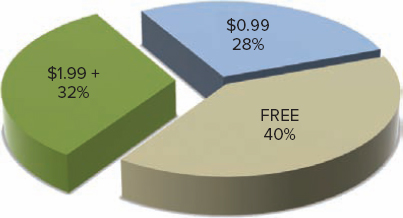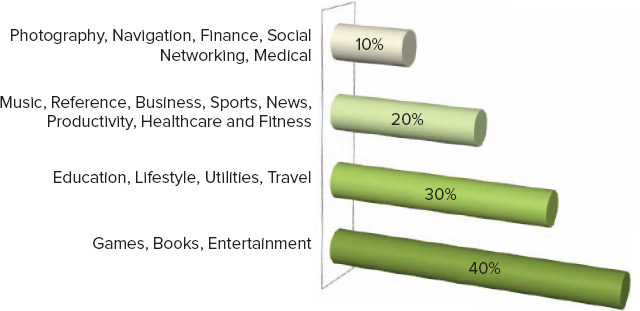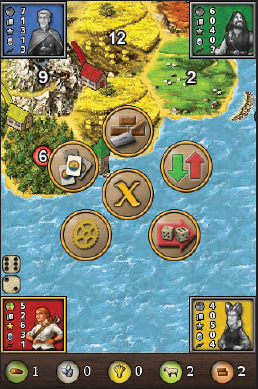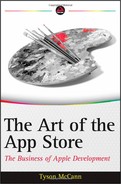UNDERSTANDING APP STORE DEMOGRAPHICS
To understand what customers seek out in an app, let's look at some of the statistics from Chapter 3 in more detail, and how understanding the end-user expectations behind them may help in your niche.
Firstly, more than one out of three apps are free, and free plus 99-cent apps equate to roughly two-thirds of all apps, as shown in Figure 4-1. So, out of roughly 500,000 active apps, about 185,000 of them are free (according to 148apps.biz), and about 315,000 are free or just 99 cents. That's huge. More than likely, customers can find what they want in some form for free, or for minimal expense, even if it is just a lite version.

FIGURE 4-1 Two of every three apps are either free or just 99 cents
The expectation in a market like this is that unless your app has some standout features and functionality — usually accompanied by glowing user/critical reviews — it likely won't be able to compete at a higher premium level. Customers in this market are just used to getting more for less.
Secondly, let's look at price. In Chapter 3, you learned that the average price of apps (not including games) is roughly $2.63, and the overall average price is roughly $2.39. Then you have games, with a rough average price of just $1.05. This tells you without a doubt that customers have plenty of choices, and they are not willing to spend more on games without good reason, but are willing to justify shelling out more than twice that amount for other types of apps.
Let's not forget that apps for the iPad (which have an average selling price of roughly $4.19 compared with that of $1.57 for the iPhone) demand a much higher price point for its apps, and, because of the device's market, is able to do so. Part of this is the smaller market size, higher price point, and, thus, “exclusivity” that the iPad affords. It's the same reason Starbucks is able to charge more for a standard cup of its coffee than the local Tim Hortons (a Northeastern U.S. and Canadian coffee chain with great coffee for the price). The other part is why customers are buying iPads in the first place — for its combination of portability, plus a large vibrant screen, usability, and overall better functionality because of the larger touch screen.
Thirdly, looking at category popularity, there are roughly four distinct sections, laid out as shown in Figure 4-2. These statistics are utilizing the latest figures (as of this writing) from 148apps.biz. To be honest, it wasn't planned this way, but it just happens to be as easy as 1, 2, 3, and 4.
Ten percent of active apps (in the order of greatest to least) fall in the categories of Photography, Navigation, Finance, Social Networking, and Medical. Twenty percent fall in Music, Reference, Business, Sports, News, Productivity, and Healthcare & Fitness. Thirty percent fall in the four categories of Education, Lifestyle, Utilities, and Travel. And nearly 40 percent fall under the big three — Games, Books, and Entertainment. The Weather category has less than 0.5 percent of active apps, and was not listed because of it possibly seeming more relevant than intended. (Perhaps opportunities exist in that niche though!)

FIGURE 4-2: Category representation of total apps
All things being equal (and they're not), if you assume that the market dictates the current App Store atmosphere, then you can assume, in general, that category saturation is roughly equivalent to customer demand within any particular category. In other words, people prefer using their i-device apps for leisure (Games, Books, Entertainment) more often, as a rule, than for productivity.
Another way of looking at it might be that, for certain types of apps, people may have one or two loaded to suit their needs (Productivity — say, a list-maker app), and for others, look for a broad range (Games). Both ways are feasible and important.
Because the Games category takes up the largest percentage of active apps, if you happen to be creating one, it will be important to have an overview of what the customer expects from certain genres, hybrids, and of the overall experience found in any current game app.
Casual and Traditional Gaming Pillars
For the most part, games have finally made the segué from “geeky” and suitable only to a mostly male demographic to being an acceptable pastime for all types of people. This is thanks in part to a casual movement brought on mostly by catering to the masses for business reasons. More buyers equals more money. Nintendo has almost always relied on this formula with its main franchises and console philosophy, and almost all the most popular i-device apps as well as games in general (“The Sims,” “Tetris”) can be defined as “casual.” Though “casual” has many definitions, it generally means “designed to appeal to as many people as possible.”
If Nintendo were to open up a store back in the old days of gaming, (say the 1980s and 1990s), the number of categories would have been fewer than in today's App Store, hybrids would be rare (“Actraiser” — a unique hybrid of action and sim-like farming is still a cult favorite), and the term casual wouldn't really exist in the same way it does today. What Apple, the App Store, and iPhone have done is take casual gaming as defined here, and infused all traditional game categories with their KISS (keep it simple, stupid) design philosophy, as well as force new categories into existence that were never quite feasible before.
Let's look at considerations when choosing a category for your game, because traditional game categories have been modified somewhat by the nature of the App Store, today's newer definition of “casual,” and the technology behind the devices themselves.
The App Store defines 19 common game categories, but with new ways of interacting (because of touch control, accelerometer, and gyroscope), many new genres and hybrids have actually been created than are shown, so it can be difficult to figure out where to place yours. For example, the popular game “Flight Control” is now considered a “line draw” game (draw a path using your finger), but there's no category for that, so they placed it in the Strategy subcategory. It does technically fit there, yet games in the Strategy subcategory have traditionally been more “hard-core.”
This is the result of the effect of “casual” on traditional game categories — that how you used to perceive them no longer applies, because users have come to expect that all games within a category will be designed with care and the end user in mind.
HARD-CORE VERSUS CASUAL
If a casual game as defined here means to appeal to as broad a range of people as possible, what does “hard-core” mean? In gaming, it has traditionally meant a game that is highly targeted to gamers looking for a specific type of experience without sacrificing complexity (sometimes in controls or interface) or depth in gameplay. In other words, games that are involved enough to require players spending some time getting used to the system—games with a steeper learning curve—can typically be considered more hard-core. World War II strategy games, for example, are most definitely hard-core, but like anything, there's a range of “hard-core-ness” to be found.
That said, many gamers today now consider themselves “hard-core,” and the term in that sense means a gamer that simply spends a lot of time with games, rather than the type of games they play. There are hard-core games and there are hardcore gamers. Both are used somewhat differently.
Likewise, a casual gamer is one whose game sessions tend to be sporadic and smaller than that of a hard-core gamer, who can spend hours at a time in front of the game.
With each app you submit, you will be able to choose from two categories — a primary (required) and secondary (optional). Many apps will be able to fit into several categories, so it's important to choose wisely, and not necessarily go with the most obvious choice.
For example, the very popular casual-friendly strategy board game “Settlers of Catan” that translated very well to the Xbox Live Arcade market and now is in the App Store (under the name “Catan,” as shown in Figure 4-3) could have been chosen for Board games, Dice games (it uses two dice), Family games (this is how it is often seen in the board game community), and, of course, Strategy. As it happens, they chose Board and Strategy. As long as it is relevant to the category, it can be approved.

FIGURE 4-3: “Catan” has four viable categories, which shows that you should choose wisely when selecting your two submission categories
It is useful to note that the Games category is unique in that, because there are subcategories, you are actually featured in the App Store in at least three places: Games, primary category 1, and secondary category 2.
Looking at the game “Tetris” shown in Figure 4-4, it was placed in the more popular Action game subcategory — likely so that more people would be aware of it, because it's a very well-known brand — as well as the obvious Puzzle subcategory. It probably could have fit in the Arcade, Strategy, or Family game subcategories as well. If you were making a similar app, however, it probably wouldn't be recommended to place it in the Action subcategory, because a gamer looking for that type of experience likely wouldn't go there. But in the case of “Tetris,” it worked.

FIGURE 4-4: “Tetris” has at least five viable categories, but was placed differently than you might expect
A good example to illustrate this is the current free (with premium content) “puzzle” title that reached as high as Number 1 in the Arcade subcategory and Number 2 in the Puzzle subcategory. Its name is “Shape Shift” (shown in Figure 4-5), a self-described puzzle title with a twist on classic puzzle gameplay. Would this title have done well in the Action subcategory? Traditionally, that subcategory would not be where you might look for a title like this, though it still may have a chance to get approved based on its twitch gameplay. Unless you have a good reason not to do so, consider your categories carefully.
Now that you're aware of potential considerations when choosing a game category, let's move on to what makes casual games on the iPhone unique.

FIGURE 4-5: “Shape Shift,” a top ranking free title with paid content, was placed in categories you might expect
iPhone Casual versus Traditional Casual
On the whole, app developers are now keen to the fact that, regardless of genre or complexity, in order to be most successful, their apps must be designed with the end user in mind. Traditional hard-core apps that are big in complexity and a beast to use would not have a market in the App Store. And, just because an app is made for a niche of sophisticated users, that doesn't mean that the experience must be anything but intuitive.
Traditionally, few games of yore would be classified as still casual in today's market. “Tetris” would be one, but “Super Mario Bros.” would not be because of its rather tough gameplay (for the average gamer) and confusing nature.
“The Sims” (the biggest selling retail game of all time to this point) was virtually the definition of casual ten years ago, and continues to sell well in its third incarnation in the App Store. It's perhaps just a bit complex to maintain as strong a presence as it did on the PC, featuring quite a bit of micromanaging. A current successful spin-off trend is taking the customization features in “The Sims,” and then creating an easier game out of it, tying it in with some monetization features like the capability to buy in-game currency to excel faster. One good example of this is “Smurfs' Village” for iPhone/iPad (Figure 4-6).

FIGURE 4-6: “Smurfs' Village” is a casual customization game that lets you create a world, share it, and play with very little stress
The invention of the iPhone has had a giant effect on all game genres in that it has brought (and continues to bring) all traditional gaming genres to a more casual level than ever before.
